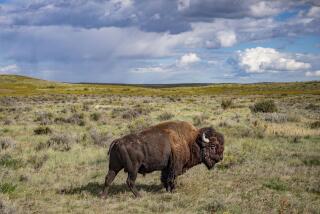Unlucky Hunter Is Memorialized : Canada: Blackfoot warrior was crushed to death, so legend has it, when a herd of bison came tumbling over cliff atop him at Head-Smashed-In Buffalo Jump.
- Share via
HEAD-SMASHED-IN BUFFALO JUMP, Canada — Many people think this place got its name because the heads of buffalo were smashed when Indians drove them over a cliff.
Not so.
It’s true that Blackfoot hunters fooled buffalo into dashing over the precipice, then joined their women in a skinning and butchering fest that provided food for the winter, tools, weapons, clothing and shelter.
As legend has it, however, the name comes from the fate of a young warrior.
He wanted to get a close look as hundreds of buffalo ran kicking and bellowing into the air, then crashed to the ground below the sandstone cliff on the eastern edge of the Porcupine Hills in Alberta.
To do this, he unwisely took up station at the bottom of the cliff, hoping to observe the rain of animals plunging to the ground as one would stand behind a waterfall and watch the water cascade into a pool.
Unfortunately for the brave, the hunt was particularly good and the stack of buffalo grew high indeed, pressing him against the cliff and covering him up. When his people came to do the butchering, they found the young man under the animals, his skull crushed by their enormous weight.
Thus, Head-Smashed-In Buffalo Jump.
There were many other buffalo jumps in the area: Old Woman Jump and Many Skulls Jump, for instance.
Only two have been preserved, said Linda Eagle Speaker, a supervisor at the visitor’s center at Head-Smashed-In. The other is Calderwood Jump, named for the owners of the ranch that includes it.
The United Nations Educational, Scientific and Cultural Organization has declared Head-Smashed-In Buffalo Jump a World Heritage Site, putting it in a category with the Great Pyramids of Egypt, Machu Picchu in Peru and India’s Taj Mahal.
The $8.4-million visitors’ center 11 miles northwest of Ft. Macleod, in Alberta, opened four years ago. Most of the building is buried in the cliff and only the front, made of the same local sandstone, is visible on approach.
A bed of bone and tools 35 feet thick lies at the bottom of the jump. The lowest level dates to the Neolithic period, or New Stone Age.
Archeological evidence shows that Head-Smashed-In was used for hunting 5,700 years ago. It was abandoned in the early 19th Century when the introduction of horses and guns made the use of such a technique unnecessary.
The Blackfoot are three tribes of plains Indians that have the same language but are independent: the Blackfoot proper, or Siksika; the Bloods, or Kainai, and the Peigan, or Pekuni.
At the visitors’ center, Eagle Speaker said, “The majority of the staff is native, and all have to speak Blackfoot.
“We’re not a museum; we are an interpretive center. People come here to touch, to feel. We teach things like flint knapping, and play games.”
Local Blackfoot, whose reservation is just across the blacktop road, are guardians of the authenticity of Head-Smashed-In.
“Our elders come about once a month,” Eagle Speaker said. “They come to advise the staff.”
They also go over all written material for accuracy and make sure that the displays are authentic, she said.
A stroll along the top of the 60-foot-high cliff on the 1,470-acre site yields a wonderful view of southern Canada’s rolling mixed-grass plains in one direction and, on a clear day, the snowcapped Rocky Mountains in the other.
At a distance, one can see the vast basin where the buffalo would gather in large herds. The visitor can imagine “buffalo runners” disguised under bison robes luring the herd forward by imitating the bleat of a lost calf.
The route to the cliff becomes progressively narrower. The animals pass between two rows of stone cairns and brush. The poorly sighted bison would dimly perceive the cairns, possibly thinking them men.
Sometimes hunters wearing a wolf or coyote skin would threaten another hunter disguised as a buffalo calf. The matriarch of the herd would maneuver to protect the calf.
Finally, near the cliff, the Indians would begin shouting and waving, stampeding the buffalo over the precipice.
More to Read
Sign up for Essential California
The most important California stories and recommendations in your inbox every morning.
You may occasionally receive promotional content from the Los Angeles Times.













